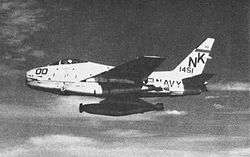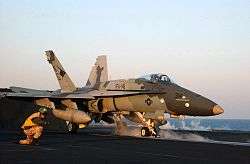VFA-146
| Strike Fighter Squadron 146 (VFA-146) | |
|---|---|
|
VFA-146 Insignia | |
| Active | 1 February 1956 - present |
| Country | United States of America |
| Branch |
|
| Type | Fighter/Attack |
| Part of | Carrier Air Wing Eleven |
| Garrison/HQ | Naval Air Station Lemoore |
| Nickname(s) | "Blue Diamonds" |
| Equipment | F/A-18 Hornet |
| Engagements |
Vietnam War Iranian Hostage Crisis Gulf War Operation Southern Watch Operation Enduring Freedom |
| Decorations |
Presidential Unit Citation Captain Michael J. Estocin Award Rear Admiral Clarence Wade McClusky Award Scott F. Kirby Award |
| Commanders | |
| Current commander | John Turner |
| Aircraft flown | |
| Attack |
A-4 Skyhawk A-7 Corsair II |
| Fighter |
F9F Cougar FJ-4B Fury F/A-18 Hornet F/A-18E Super Hornet |
Strike Fighter Squadron 146 (VFA-146) also known as the "Blue Diamonds" is a United States Navy operational fleet strike fighter squadron based at Naval Air Station Lemoore California. They fly the F/A-18E Super Hornet and are attached to Carrier Air Wing 11 (CVW 11), deployed aboard USS Nimitz. Their tailcode is NH and their radio callsign is Diamond.
Squadron Insignia and Nickname
The first insignia for VA-146 was approved by CNO on 23 November 1956, consisting of two concentric circles, a yellow mach wave symbol and a yellow globe showing North and South America. The first nickname the squadron reported to have used was Blacktails. This name was in reference to the black color assigned to the squadron’s position in the air group. The nickname Blue Diamonds was adopted by the squadron sometime in the late 1950s. In 1968 the squadron elected to simplify their insignia and bring it in concert with their nickname. Their current insignia was revised and approved on 29 August 1968.
History
1950s

On 1 February 1956 Attack Squadron 146 (VA-146) became the Navy's newest jet attack squadron at NAS Miramar. Since there were no fleet replacement squadrons at this time, VA-146 started with only a handful of aircraft and began an "in-house" training regime in various models of the F9F Cougar. Their first deployment was aboard USS Hornet in 1957. In September 1957, the squadron transitioned to the FJ-4B Fury, deploying twice aboard USS Ranger prior to 1960.
1960s
On 17 January 1960, VA-146 Furys participated in a coast to coast non-stop cross country flight.
The squadron deployed Furys aboard USS Oriskany and USS Lexington.

In May 1962 the squadron moved to NAS Lemoore, and transitioned to the A-4 Skyhawk in June 1962. The squadron's first Skyhawk deployment was to the Western Pacific aboard USS Constellation.
From June to September 1964, while operating from USS Constellation off Yankee Station, VA-146 participated in photo reconnaissance missions over Laos. The squadron’s A-4C Skyhawks were used to provide tanker and rocket-armed escort support for the photo reconnaissance sorties over Laos and South Vietnam. During this time, VA-146 aircraft also flew night sorties in support of DESOTO Patrol operations (the collection of signal intelligence) conducted by American destroyers operating in international waters off the coast of North Vietnam). In response to North Vietnamese torpedo boat attacks against USS Maddox and USS Turner Joy on 2 August 1964, VA-146 participated in Operation Pierce Arrow, retaliatory air strikes against North Vietnamese targets which resulted in the sinking or damaging of 8 torpedo boats, and marked the first use of the A-4 in combat.
On 29 June 1966, a 28-plane strike of VA-146 and other CVW-14 aircraft flying from USS Ranger struck the Haiphong Petroleum storage complex, the first American strike against this complex.
In December 1968 under the instruction of VA-125, VA-146 transitioned to the A-7B Corsair II. The squadron received its first A-7 on 4 June 1968 and deployed aboard USS Enterprise on 6 January 1969. Shortly after deployment in September 1969, the squadron upgraded to the A-7E.
1970s

In April 1970, the squadron embarked aboard USS America at NS Norfolk for her extended combat deployment to Vietnam, returning in December 1970. In December 1971, VA-146 became the first Navy squadron to use a laser-guided bomb (LGB) in combat. In May 1972 the squadron’s A-7Es conducted night mining missions to North Vietnamese rivers. On January 5, 1973, VA-146 headed west with Carrier Air Wing Nine (CVW-9) embarked again on USS Constellation. This cruise would bring to an end Navy's participation in the Vietnam War. For the deployment, USS Constellation and CVW 9 were awarded the Presidential Unit Citation.
In November 1974, while aboard USS Constellation, VA-146 operated in the Persian Gulf, the first time in 26 years that an American carrier had entered and operated there.
1980s

In early 1980, VA-146 was named the safest A-7 squadron in combined Navy-Air Force history by surpassing all previous records for accident-free flight operations at 36,175 hours. In February 1980, VA-146 made the first Pacific deployment with the new Forward Looking Infrared (FLIR) system installed on the A-7. During the 1980 deployment aboard USS Constellation, the squadron spent 110 days at sea, the longest continuous at-sea period for any West Coast carrier since World War II.
In 1983 the squadron was tasked with fleet introduction of the HARM missile system, and their 14-year association with CVW-9 was broken when VA-146 was reassigned to Carrier Air Wing 2. Upon their return from a WestPac deployment aboard USS Kitty Hawk in August 1984, the squadron was again reassigned to CVW-9. In September 1988, VA-146 embarked aboard USS Nimitz for a Western Pacific deployment. The highlight of this cruise were operations in the Sea of Japan during the 1988 Summer Olympics.
On 21 July 1989, VA-146 was redesignated Strike Fighter Squadron ONE HUNDRED FORTY SIX (VFA-146), and they received their first F/A-18 Hornet on 18 November 1989.
1990s
The squadron spent the majority of 1997 preparing for a World Cruise aboard USS Nimitz, and extended their 13-year history of over 55,000 hours without a Class "A" safety mishap. The highlight of the work-up cycle was a 96-hour sortie surge operation in which they flew 226 sorties. On 4 September 1997, the squadron departed San Diego with the USS Nimitz Battle Group in support of Operation Southern Watch. Shortly after their return to NAS Lemoore, the squadron was named the 1997 COMNAVAIRPAC Battle "E" winner and were also awarded the Captain MichaelJ. Estocin, Rear Admiral C. Wade McClusky and the Scott F. Kirby Awards.
2000s

On November 12, 2001 the squadron deployed with CVW-9 on the USS John C. Stennis to conduct combat operations in support of Operation Enduring Freedom over Afghanistan. The squadron deployed two months early in response to the September 11 attacks. Port calls on the way included Hong Kong and Singapore arriving in the North Arabian Sea. On December 12, 2001 the squadron began their first night strikes into Afghanistan. The missions ranged from 4.5 to 6.0 hours with help from the Roosevelt Battle Group and the Kennedy Battle Group. The squadron amassed over 3500 flight hours and delivering over 102,000 pounds of ordnance. Milestones included extending their Top Hook Award streak to 24 after the first line period. Weapons included the JDAM, Laser Guided Bombs, and Mark 82 bombs. The squadron returned at the end of May 2002 after a stopover in Australia and a Tiger Cruise from Hawaii. The squadron began a cruise aboard USS Carl Vinson on January 17, 2005. The "around-the-world" deployment took them across the Pacific and Indian Oceans into the Persian Gulf. For three months the squadron, along with the rest of CVW-9, flew missions in support of Operation Iraqi Freedom. The USS Carl Vinson then turned south to steam around the Sinai Peninsula into the Red Sea, through the Suez Canal, the Mediterranean Sea, then across the Atlantic. On July 31, 2005, the USS Carl Vinson pulled into its new homeport of Naval Station Norfolk for a scheduled nuclear refuelling.
2010s
In 2015, VFA-146 transitioned from the F/A-18C to the newer F/A-18E Super Hornet.[1]
See also
References
- Web
- "Official Website: VFA-146 Blue Diamonds". Retrieved 2013-02-23.
- "Global Security.org: VFA-146 Bluediamonds". Retrieved 2006-10-30.
External links
-
 Media related to Strike Fighter Squadron 146 at Wikimedia Commons
Media related to Strike Fighter Squadron 146 at Wikimedia Commons - Skyhawk Association
- VFA-146 (Official Website)
- Carrier Air Wing Eleven (Official Website)

